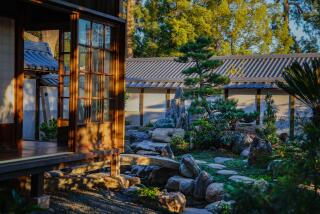Looking Into the Quintessential Victorian Palace of Glass
- Share via
NEW YORK — On a sunny spring morning, it really does look like a crystal palace floating over the gardens, a vision of airy splendor.
It’s the quintessential Victorian glasshouse, the country’s largest. Its formal name is the Enid A. Haupt Conservatory, at the New York Botanical Garden, and it has reopened after a four-year, $25-million restoration that included replacing by hand each of the 17,000 glass panes.
The conservatory was built between 1898 and 1902 by Lord & Burnham, then America’s foremost greenhouse architects. The architectural firm of Beyer Blinder Belle, New York, designed the restoration. Project manager Richard Southwick says other Lord & Burnham glass houses that survive are in Buffalo, Old Westbury, N.Y., and San Francisco.
“But they don’t have the elegance, they don’t soar to the height of this palm house,” he said. “This is a real masterpiece in design and execution. It was done in a very exquisite manner.”
Belying its delicate look, the structure has been strengthened by full reconstruction, its fine lines forged in new steel, aluminum replacing the wood structure system that held the glass in place.
“We went to the Lord & Burnham archives at the beginning of our project. The original designs for this one are gone, but we were able to compare other designs they were doing around the same period. And this was a very well-photographed building, right from day one, back in 1898,” Southwick said.
The idea of the glasshouse owed something to the British in their days of Empire, Southwick said, and to their enthusiasm for bringing back exotic plants from faraway places. Then too the industrial revolution encouraged the idea of man’s mastery over nature.
“There was something very special about bringing a tropical environment to the Bronx in the middle of winter,” Southwick said.
This kind of glasshouse was inspired by England’s Kew Gardens and by London’s mid-19th century Crystal Palace, stylistically as well as technologically, Southwick said.
The conservatory is a C-shaped complex. Its central palm house with a 90-foot-high dome is flanked by 10 pavilions in two wings.
The conservatory now houses “A World of Plants,” an extensive exhibition ranging from tropical rain forest to desert, as well as temporary exhibition space.






